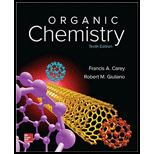
Concept explainers
Interpretation:
The molecular structures for the compounds A through D, which are consistent with the observed transformations, are to be assigned.
Concept Introduction:
>Alkylation of acetylene takes place in two steps.In the first step, the acetylene is treated with sodium amide, which converts it to its conjugate base. In step two, the acetylide ion reacts with an
Repeating the alkylation sequence of steps using a different alkyl halide converts the acetylene to its disubstituted derivative. The triple bond is internal in this derivative.
>Ozonolysis of
In ozonolysis, each of the triple bonded carbon atoms changes to the carboxyl carbon.
>In case of terminal alkynes, one of the products of ozonolysis is carbonic acid, which further dissociates into carbon dioxide and water.
Want to see the full answer?
Check out a sample textbook solution
Chapter 9 Solutions
ORGANIC CHEMISTRY (LL)-W/SOLN.>CUSTOM<
- Wolff-Kishner reduction of compound W gave compound A. Treatment of A with m-chloroperbenzoic acid gave B which on reduction with LiAH4 gave C. Oxidation of compound C with chromic acid gave D (C9H14O). Suggest the structures for A, B, C, and D.arrow_forwardIn the following sequence of reactions which products are identified correctly? Compound A (C 7H 11B1) is treated with magnesium in ether to give B (C 7H 11MgBr), which reacts violently with D 20 to give 1-methylcyclohexene B with acetone (CH 3COCH 3) followed by hydrolysis gives D (C 10H 180). Heating D with with a deuterium atom on the methyl group C. Reaction concentrated H 2SO 4 gives E (C 10H 16), which decolorizes two equivalents of Br 2 to give F (C 10H 16Br 2). E undergoes hydrogenation with excess H 2 and a Pt catalyst to give isobutylcyclohexane. O The correct structure of C is OH O The correct structure of D is O The correct structure of C is Br OI The correct structure of F is 8rarrow_forwardTwo isomers, A and B, of molecular formula C5H8 undergo catalytic hydrogenation with hydrogen gas and palladium on carbon to form the same C5H10 product. On ozonolysis followed by treatment with hydrogen peroxide (H₂O2), isomer A gave a product of molecular formula C5H8O4 that has two carboxylic acid groups in it whereas isomer B gave a product of molecular formula C5H8O3 that contains a carboxylic acid group and a ketone group. Which of the following isomeric pairs best match this data? a. Isomer A is cyclopentene and isomer is 1-pentyne O b. Isomer A is cyclopentene and isomer B is 1-methylcyclobutene c. Isomer A is cyclopentene and isomer B is 3-methylcyclobutene d. Isomer A is 1-methylcyclobutene and isomer B is 3-methylcyclobutenearrow_forward
- b) Compound A, C;H14 undergo hydration to form B which is optically active. Compound A reacts with cold alkaline potassium manganate (VII) to form C. Ozonolysis of compound A forms methanal and 3,3-dimethylbutanal. Deduce structure A, B, and C.arrow_forwardTwo isomers, A and B, of molecular formula C5H8 undergo catalytic hydrogenation with hydrogen gas and palladium on carbon to form the same C5H10 product. On ozonolysis followed by treatment with hydrogen peroxide (H2O2), isomer A gave a product of molecular formula C5H8O4 that has two carboxylic acid groups in it whereas isomer B gave a product of molecular formula C5H8O3 that contains a carboxylic acid group and a ketone group. What is the isometric pair of A and B that corresponds?arrow_forwardTwo isomers, A and B, of molecular formula C5H8 undergo catalytic hydrogenation with hydrogen gas and palladium on carbon to form the same C5H10 product. On ozonolysis followed by treatment with hydrogen peroxide (H2O2), isomer A gave a product of molecular formula C5H8O4 that has two carboxylic acid groups in it whereas isomer B gave a product of molecular formula C5H8O3 that contains a carboxylic acid group and a ketone group. Which of the following isomeric pairs best match this data?arrow_forward
- Carototoxin is a natural pesticide produced by carrots, with formula C₁H2O. It undergoes hydrogenation with Pd to: give product A, C,H,O, and with Lindlar's catalyst to give product B, C,H2O. Ozonolysis followed by zinc leads to a mixture of methanal, octanal, 1,2-ethanedioic acid, 3-oxopropanoic acid, and 2-hydroxy-3-oxopropanoic acid. Draw possible structures for carototoxin, A, and B. Product B structure H2, Lindlar's Structure of carototoxin H2, Pd/C Product A structurearrow_forwardGrignard reagent is a versatile tool in synthetic organic chemistry. Using bromocyclopentane as a starting material, show how a Grignard reagent, X, is synthesized. Reaction of X with water produces compound Y while treatment in carbon dioxide followed by hydrolysis forms compound Z. 3-methyl-2butanone reacts with X and hydrolyses to yield compound AA. Draw the structural formulae of compounds Y, Z and AA and write the chemical equations respectively.arrow_forwardIsoerythrogenic acid, C18H26O2, is an acetylic fatty acid that turns a vivid blue on exposure to UV light. On Catalytic hydrogenation over a palladium catalyst, five molar equivalents of hydrogen are absorbed, and stearic acid, CH3(CH2)16CO2H, is produced. Ozonolysis of isoerythrogenic acid yields the following products: formaldehyde, CH2O, malonic acid, HO2CCH2CO2H, adipic acid, HO2C(CH2)4CO2H, and the aldehyde carboxylic acid, OHC(CH2)6CO2H. Provide a structure for isoerythrogenic acid.arrow_forward
- Deduce the structures of compounds A and B, two of the major components of jasmine oil, from the given data. Compound A: C9H10O2; IR absorptions at 3091–2895 and 1743 cm-1; 1H NMR signals at 2.06 (singlet, 3 H), 5.08 (singlet, 2 H), and 7.33 (broad singlet, 5 H) ppm. Compound B: C14H12O2; IR absorptions at 3091–2953 and 1718 cm-1; 1H NMR signals at 5.35 (singlet, 2 H) and 7.26–8.15 (multiplets, 10 H) ppm.arrow_forwardasaparrow_forwardAn alkene with molecular formula C8H16 was obtained from ozonolysisreaction and give acetone and 2,2-dimethylpropanal as the product. Writethe chemical equation from the reactionarrow_forward
